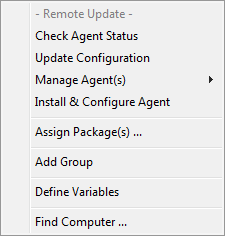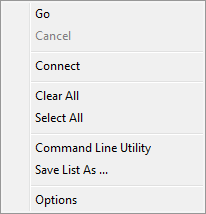|
Remote Update helps you install and configure the EventSentry agent on a number of computers. Remote Update has the following capabilities divided into three categories:
Check Agent Status
| • | Retrieves the current agent status and installed version from a number of hosts to help you make sure that the EventSentry agent is running and has the latest version. |
Update Configuration
| • | Pushes the current configuration to the remote host(s) |
Perform Action
| • | Install the service (including necessary files) |
| • | Update the service executable on remote computers |
| • | Uninstall the service (including files and configuration) |
| • | Start the service on remote computers |
| • | Stop the service on remote computers |
| • | Disable the EventwatchNT service on remote computers |
| • | Uninstall EventwatchNT from remote computers |
Requirements
Starting with EventSentry v2.72, remote update no longer requires remote registry access in order to push out the configuration. Instead, only the ADMIN$ share or the ES$ share (details see below) are required.
The remote update tasks have different requirements, depending on which action is performed. The table below shows you which tasks have which requirements.
Remote Update Requirements
|
|
|
|
- required access/features on remote host -
|
Remote Update Task
|
Remote Registry
|
ADMIN$
|
ES$
|
Service Control Manager
|
|
|
|
|
|
Install Service
|
optional, to set automatic service restart option
|
yes, to copy service file and initial configuration
|
if the RemoteUpdate subdirectory exists
|
yes, to install service
|
Uninstall Service
|
yes, to remove config
|
yes, to remove service file
|
no
|
yes, to uninstall service
|
|
|
|
|
|
Update Configuration
|
no
|
yes, if ES$ not present
|
if the RemoteUpdate subdirectory exists
|
no
|
Update Configuration
(with "minimize traffic" activated)
|
no
|
optional, to query version
of remote agent
|
if the RemoteUpdate subdirectory exists
|
no
|
|
|
|
|
|
Check Agent Status
|
no
|
yes, to query version
of remote agent
|
no
|
yes, to query the current
service status
|
Update Agent
|
no
|
yes, to update service file
|
if the RemoteUpdate subdirectory exists
|
yes, to stop and
start service
|
|
|
|
|
|
Start Service
|
no
|
no
|
no
|
yes
|
Stop Service
|
no
|
no
|
no
|
yes
|
For example, to update the configuration on a remote host, the remote host either needs to have the ADMIN$ share or the ES$ share present. To install the service remotely, the ADMIN$ share is mandatory and access to the service control manager is also required.
To perform a Remote Update:
| 1. | Make sure that the service files (eventsentry_svc.exe, eventsentry_svc.exe) are accessible on the Template Computer. |
| 2. | Add all the computers that you would like to update to the Computer list. If you would like to add computers from a text file, the network neighborhood or Active Directory then right-click a group and choose Import. Please see the next page for details on importing computers. You will not be able to add the local computer name into this list since it is assumed to already be up-to-date and to serve as the template.. |
| 3. | Right-click a group or right-click Groups. The former will only update computers in the selected group while the latter will update all computers from all groups. |
| 4. | Choose the desired category from the context menu |

|

Context menu for all groups
|
Context menu for a group
|
|
| 5. | Click on a category for more details: |
| 6. | If you selected Use Checkboxes then you will now need to check the computers to which the update should be applied to. Then right-click the list and choose Go from the context menu or click the green arrow in the toolbar. |
Saving the results
You can always save the results of any remote update status / update / action by right-clicking the list and selecting Save List As.

This will save the current output in a text file.
Repeating an update
If you would like to repeat any status / update / action then right-click the list and select Repeat Update. The last action you performed will repeated.

Note: If you activated the Use Checkboxes feature then you will need to click on Go instead of Repeat Update.

|
The Remote Update feature is most useful for installing the service on a large number of hosts for the first time and for applying common configuration settings (e.g. an SMTP action and a default include filter) to all hosts in a short period of time.
|
|





